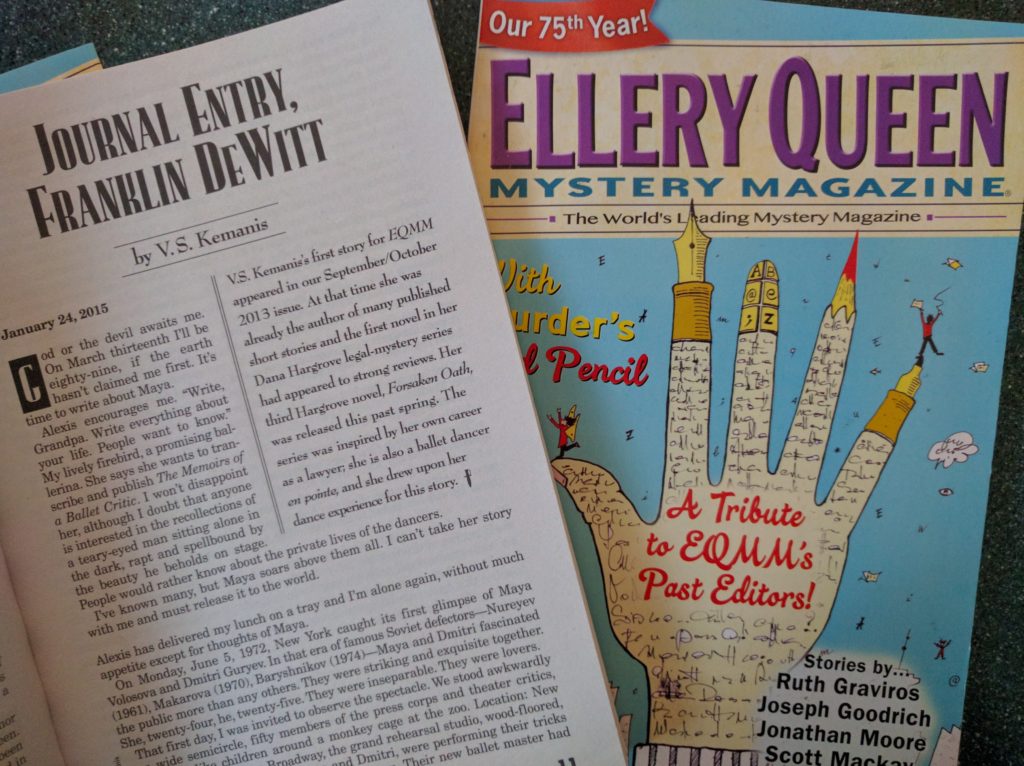We Were the Mulvaneys and TransAtlantic: Book reviews
Years ago, an editor of a major lit mag sent me a “nice” rejection note, extolling the beauty of my story before delivering the kicker: “Your sentences are too long.” I spent the day grumbling about the unfairness of coming “this” close to getting in (sliver of air between thumb and index finger), and then I got to work on the sentences. Months later, when I read the story again, I discovered the improvement. The editor was right. The story I speak of is “Tidal Waters,” which appears in my collection Dust of the Universe.
The obvious lesson here for any writer is to accept criticism, act on good advice, and strive for improvement. The second lesson is to pay attention to sentence length. (As a side benefit, this happens to be a truly fun topic for any language and grammar geek!)
Paragraph-length sentences are commonplace in the flowery prose of 19th century novels (“It was the best of times, it was the worst of times…”) We wouldn’t want to change a word of Dickens or the Brontës. But for contemporary fiction, which do you prefer: a sentence of 210 words or a three-word fragment? You’ll find plenty of the former in We Were the Mulvaneys by Joyce Carol Oates, and an abundance of the latter in TransAtlantic by Colum McCann.
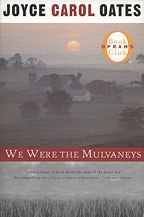 In The Mulvaneys, near the end, a 210-word sentence describes a family softball game, with vivid depictions of five characters, the pitcher, batter, umpire, first baseman and third baseman. I’d venture to guess that the novel contains hundreds of sentences this length or longer, jamming the many page-length paragraphs that rush headlong toward elusive end points. I didn’t stop to count the words. I was too busy reading, too enthralled. After closing the last page and drying my tears, I took a moment to mourn my personal loss of the Mulvaneys, as my real-life living room slowly came into focus—a world without them. After getting through all of that, I remembered the sentence about the softball game, went back, and counted the words.
In The Mulvaneys, near the end, a 210-word sentence describes a family softball game, with vivid depictions of five characters, the pitcher, batter, umpire, first baseman and third baseman. I’d venture to guess that the novel contains hundreds of sentences this length or longer, jamming the many page-length paragraphs that rush headlong toward elusive end points. I didn’t stop to count the words. I was too busy reading, too enthralled. After closing the last page and drying my tears, I took a moment to mourn my personal loss of the Mulvaneys, as my real-life living room slowly came into focus—a world without them. After getting through all of that, I remembered the sentence about the softball game, went back, and counted the words.
Perhaps you know the Mulvaneys. They comprise that large, noisy clan inhabiting a farmhouse on several acres in upstate New York. The decade is the seventies. They lead exemplary lives, a father and mother, three boys and a girl. The parents are demonstrably in love to the point of embarrassing their kids, every one exceptional: a high school star athlete, a sweet and popular cheerleader, a class valedictorian, and the youngest, an observer of life who grows up to become a newspaperman. Horses, sheep, chickens, cats, dogs, parrots, rabbits, and deer keep the Mulvaneys company up there on the “farm,” although they don’t seem to be doing much farming. The father runs a roofing business and the mother buys and sells antiques. Daily life includes cooperative work rosters, family dinners, a tumultuous togetherness, Christian values. The manic wonderfulness of this life primes us for the hinted-at fall from grace. It’s coming. The catalyst is an unspeakable crime. An act of mere minutes defines a life. One Mulvaney falls, then another. Impotence, futility, revenge. A slow unraveling. Separation. Everyone ruined. Finally, the denouement. A small redemption.
You’ve noticed that, in the paragraph just concluded, I slipped into short, compact sentences and fragments. More on that when we come to TransAtlantic. For now, let’s return to The Mulvaneys.
I don’t mean to say that every sentence in this book is long. That familiar bit of advice for writers—to vary your sentence length—is properly on display. But the writing is extremely busy, complex, and chock-full of detail. For example, we’re treated to an itemization of the myriad objects that accumulate on the edges of the staircase in the Mulvaney home, from thumbtacks and stray gloves to a necktie stained with spaghetti sauce and two blue ribbons from 4-H projects. Some readers, judging by their reviews, are not fans of this kind of detail. Why do we need to know every single nickname for each family member, dog, cat, and horse?
Certainly, Oates is known for her prolixity, but is that a good or a bad thing when it comes to The Mulvaneys? Completely good, I say. I loved this book with its messy writing, the emotional intensity, and urgent tone. Every rule of “good” writing is broken. Besides the run-on sentences, you’ll find overuse of italics and exclamation points and dashes and parentheticals, abrupt changes in point of view from first person narrator to third person omniscient observer, and most delightful of all, abundant non sequiturs. (Are these thoughts, and if so, who is thinking them?) Taking a hatchet to this in the name of good grammar would have stripped the novel of its emotional impact. The very busyness of the writing imparts the chaotic flavor of this household, bringing the reader straight into its heart. Having grown up in a boisterous household within a family larger than the Mulvaneys, I felt right at home. The novel also explores a few of my favorite themes in psychological fiction. Self-deception, and the inability to understand how one’s behavior affects another. The ways in which lives are forever changed by a single, fleeting interaction.
[Note to those of you who’ve read this novel: Didn’t you love the firefly story and Corinne’s implied admission about it at the end?]
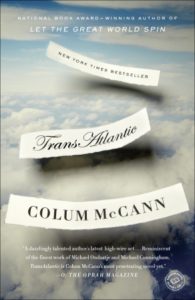 On to TransAtlantic by Colum McCann. The construct of this novel is unique. McCann takes three fact-based story lines about men in history who’ve made transatlantic crossings and links their stories—albeit tenuously—with the personal stories of women who’ve played tangential roles in these events. The first part of the book takes history out of order: 1919, the first nonstop flight across the Atlantic Ocean by aviators Jack Alcock and Arthur Brown, Newfoundland to Ireland. (This was my favorite, but unfortunately, the shortest, at 31 pages.) 1845, freed slave and abolitionist Frederick Douglass, on a lecture tour for his autobiography in Ireland. 1998, Senator George Mitchell brokering peace talks in Northern Ireland. The women and their families, spanning five generations, provide the thread linking these events. The second part of the book takes these generations in chronological order, in four sections dated 1863-1889, 1929, 1978, and 2011.
On to TransAtlantic by Colum McCann. The construct of this novel is unique. McCann takes three fact-based story lines about men in history who’ve made transatlantic crossings and links their stories—albeit tenuously—with the personal stories of women who’ve played tangential roles in these events. The first part of the book takes history out of order: 1919, the first nonstop flight across the Atlantic Ocean by aviators Jack Alcock and Arthur Brown, Newfoundland to Ireland. (This was my favorite, but unfortunately, the shortest, at 31 pages.) 1845, freed slave and abolitionist Frederick Douglass, on a lecture tour for his autobiography in Ireland. 1998, Senator George Mitchell brokering peace talks in Northern Ireland. The women and their families, spanning five generations, provide the thread linking these events. The second part of the book takes these generations in chronological order, in four sections dated 1863-1889, 1929, 1978, and 2011.
This is a lot of territory to cover in a novel of 300 pages, and the thread takes some effort to follow. We meet the progenitor in the second chapter, Irish housemaid Lily Duggan, who crosses paths with Frederick Douglass. Lily’s daughter and granddaughter, Emily, a writer, and Lottie, appear in the first chapter about Alcock and Brown. Lottie, as an old woman, and her daughter Hannah make a brief appearance in the chapter about Senator Mitchell. The second part of the book expands on the lives of the women, weaving in brief references to the historical figures and their influence.
The writing is full of short sentences and fragments. At times, it was like reading a telegram. Take this paragraph, for example: “News comes later in the morning. A murder in Derry. A member of the paramilitaries. The statements are out. The press releases. The men of violence. Pointless retaliation. Trevor Deeney. Sitting in a car beside his wife. Shot point-blank. For what reason? Is there ever a reason? There will be retaliation. Already promised.” After this, seven more short sentences finish up this paragraph!
For me, the whiplash from constant starting and stopping detracted from the theme of continuation and linkage. The characters are not fully rendered, and I wanted to know them better. On the plus side, the writing is full of beautiful and startling images, unique metaphors, and unlikely juxtapositions of words. The craft and talent in this are awe-inspiring for any writer. “The Great War had concussed the world.” “Europe was a crucible of bones.” “The sky lifts the hem of Belfast.” “The damp white loaf of his body shuddered.” “The old hieroglyphics of violence” (referring to a scorch mark under a new square of wallpaper).
To contrast: How did the two writing styles affect my enjoyment of the novels? The difference was this. In The Mulvaneys, the writing does not care about itself and simply carried me along. In TransAtlantic, the writing acquired a self-importance and became the prominent feature, drawing me away from the story.
I close with this, a thank you to Colum McCann for an apt metaphoric description of a writer’s labor, taken from the viewpoint of his character Emily: “The elaborate search for a word, like the turning of a chain handle on a well. Dropping the bucket down the mineshaft of the mind. Taking up empty bucket after empty bucket until, finally, at an unexpected moment, it caught hard and had a sudden weight and she raised the word, then delved down into the emptiness once more.”
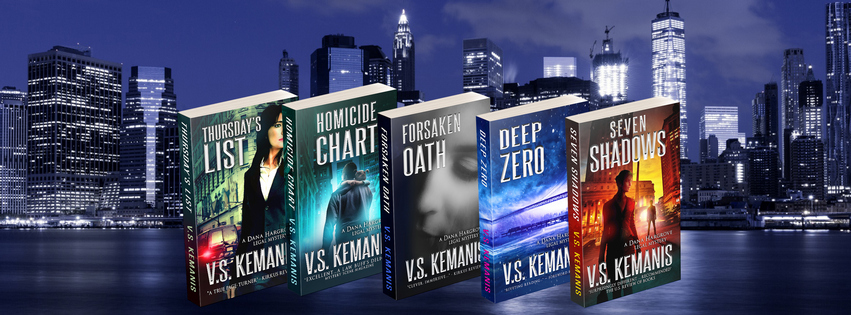
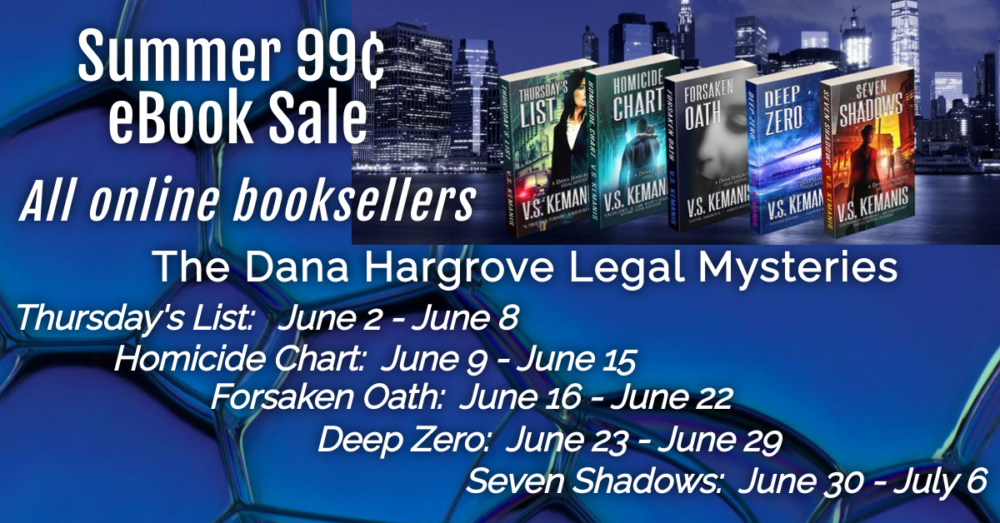





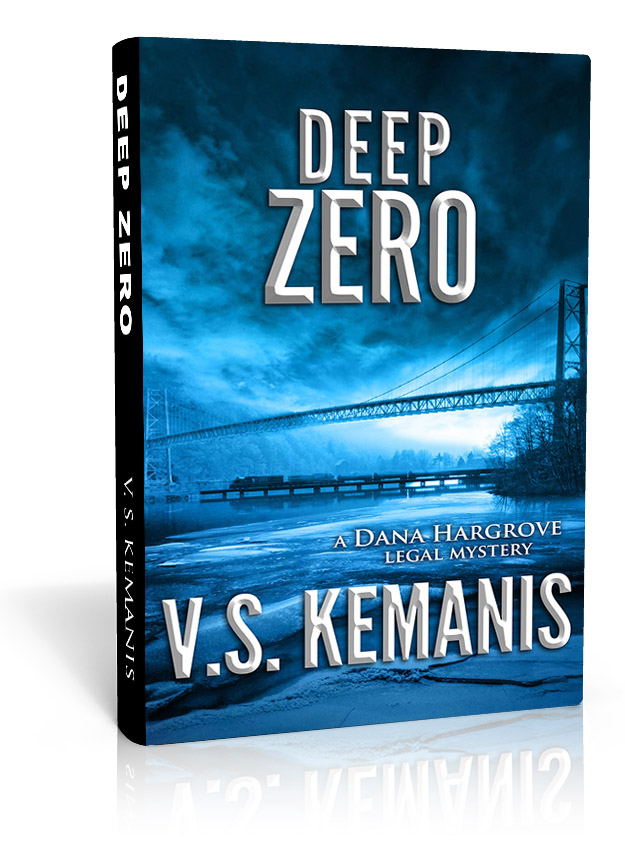
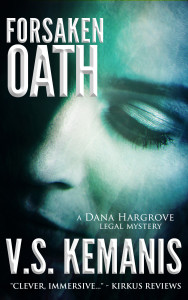 “Kirkus recently reviewed three legal thrillers that focus on resourceful attorneys pursuing justice. In V.S. Kemanis’
“Kirkus recently reviewed three legal thrillers that focus on resourceful attorneys pursuing justice. In V.S. Kemanis’ 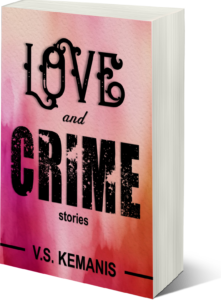 es big and small… Crimes forgiven or avenged…
es big and small… Crimes forgiven or avenged… In The Mulvaneys, near the end, a 210-word sentence describes a family softball game, with vivid depictions of five characters, the pitcher, batter, umpire, first baseman and third baseman. I’d venture to guess that the novel contains hundreds of sentences this length or longer, jamming the many page-length paragraphs that rush headlong toward elusive end points. I didn’t stop to count the words. I was too busy reading, too enthralled. After closing the last page and drying my tears, I took a moment to mourn my personal loss of the Mulvaneys, as my real-life living room slowly came into focus—a world without them. After getting through all of that, I remembered the sentence about the softball game, went back, and counted the words.
In The Mulvaneys, near the end, a 210-word sentence describes a family softball game, with vivid depictions of five characters, the pitcher, batter, umpire, first baseman and third baseman. I’d venture to guess that the novel contains hundreds of sentences this length or longer, jamming the many page-length paragraphs that rush headlong toward elusive end points. I didn’t stop to count the words. I was too busy reading, too enthralled. After closing the last page and drying my tears, I took a moment to mourn my personal loss of the Mulvaneys, as my real-life living room slowly came into focus—a world without them. After getting through all of that, I remembered the sentence about the softball game, went back, and counted the words. On to TransAtlantic by Colum McCann. The construct of this novel is unique. McCann takes three fact-based story lines about men in history who’ve made transatlantic crossings and links their stories—albeit tenuously—with the personal stories of women who’ve played tangential roles in these events. The first part of the book takes history out of order: 1919, the first nonstop flight across the Atlantic Ocean by aviators Jack Alcock and Arthur Brown, Newfoundland to Ireland. (This was my favorite, but unfortunately, the shortest, at 31 pages.) 1845, freed slave and abolitionist Frederick Douglass, on a lecture tour for his autobiography in Ireland. 1998, Senator George Mitchell brokering peace talks in Northern Ireland. The women and their families, spanning five generations, provide the thread linking these events. The second part of the book takes these generations in chronological order, in four sections dated 1863-1889, 1929, 1978, and 2011.
On to TransAtlantic by Colum McCann. The construct of this novel is unique. McCann takes three fact-based story lines about men in history who’ve made transatlantic crossings and links their stories—albeit tenuously—with the personal stories of women who’ve played tangential roles in these events. The first part of the book takes history out of order: 1919, the first nonstop flight across the Atlantic Ocean by aviators Jack Alcock and Arthur Brown, Newfoundland to Ireland. (This was my favorite, but unfortunately, the shortest, at 31 pages.) 1845, freed slave and abolitionist Frederick Douglass, on a lecture tour for his autobiography in Ireland. 1998, Senator George Mitchell brokering peace talks in Northern Ireland. The women and their families, spanning five generations, provide the thread linking these events. The second part of the book takes these generations in chronological order, in four sections dated 1863-1889, 1929, 1978, and 2011.